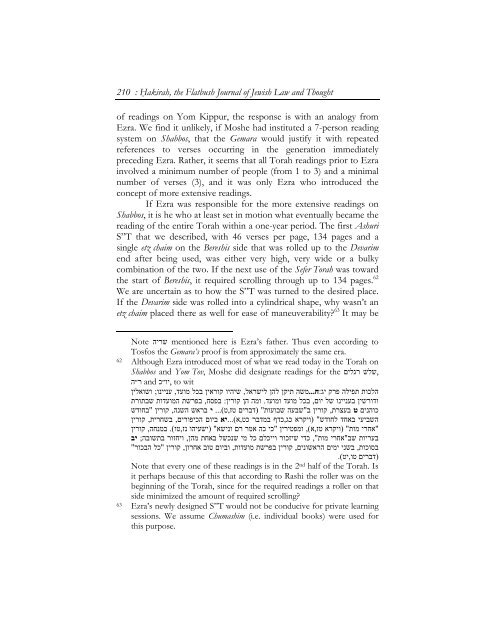Symmetrically Designed Sifrei Torah: A Quantitative Analysis - Hakirah
Symmetrically Designed Sifrei Torah: A Quantitative Analysis - Hakirah
Symmetrically Designed Sifrei Torah: A Quantitative Analysis - Hakirah
Create successful ePaper yourself
Turn your PDF publications into a flip-book with our unique Google optimized e-Paper software.
210 : Hạkirah, the Flatbush Journal of Jewish Law and Thought<br />
of readings on Yom Kippur, the response is with an analogy from<br />
Ezra. We find it unlikely, if Moshe had instituted a 7-person reading<br />
system on Shabbos, that the Gemara would justify it with repeated<br />
references to verses occurring in the generation immediately<br />
preceding Ezra. Rather, it seems that all <strong>Torah</strong> readings prior to Ezra<br />
involved a minimum number of people (from 1 to 3) and a minimal<br />
number of verses (3), and it was only Ezra who introduced the<br />
concept of more extensive readings.<br />
If Ezra was responsible for the more extensive readings on<br />
Shabbos, it is he who at least set in motion what eventually became the<br />
reading of the entire <strong>Torah</strong> within a one-year period. The first Ashuri<br />
S”T that we described, with 46 verses per page, 134 pages and a<br />
single etz chaim on the Bereshis side that was rolled up to the Devarim<br />
end after being used, was either very high, very wide or a bulky<br />
combination of the two. If the next use of the Sefer <strong>Torah</strong> was toward<br />
the start of Bereshis, it required scrolling through up to 134 pages. 62<br />
We are uncertain as to how the S”T was turned to the desired place.<br />
If the Devarim side was rolled into a cylindrical shape, why wasn’t an<br />
etz chaim placed there as well for ease of maneuverability? 63 It may be<br />
Note שריה mentioned here is Ezra’s father. Thus even according to<br />
Tosfos the Gemara’s proof is from approximately the same era.<br />
62 Although Ezra introduced most of what we read today in the <strong>Torah</strong> on<br />
,שלש רגלים Shabbos and Yom Tov, Moshe did designate readings for the<br />
to wit ,יו״כ and ר״ה<br />
הלכות תפילה פרק יג:ח...משה תיקן להן לישראל, שיהיו קוראין בכל מועד, עניינו; ושואלין<br />
ודורשין בעניינו של יום, בכל מועד ומועד. ומה הן קורין: בפסח, בפרשת המועדות שבתורת<br />
כוהנים ט בעצרת, קורין ב"שבעה שבועות" (דברים טז,ט)... י בראש השנה, קורין "בחודש<br />
השביעי באחד לחודש" (ויקרא כג,כדף במדבר כט,א)...יא ביום הכיפורים, בשחרית, קורין<br />
"אחרי מות" (ויקרא טז,א), ומפטירין "כי כה אמר רם ונישא" (ישעיהו נז,טו). במנחה, קורין<br />
בעריות שב"אחרי מות", כדי שיזכור וייכלם כל מי שנכשל באחת מהן, ויחזור בתשובה; יב<br />
בסוכות, בשני ימים הראשונים, קורין בפרשת מועדות, וביום טוב אחרון, קורין "כל הבכור"<br />
(דברים טו,יט).<br />
Note that every one of these readings is in the 2 nd half of the <strong>Torah</strong>. Is<br />
it perhaps because of this that according to Rashi the roller was on the<br />
beginning of the <strong>Torah</strong>, since for the required readings a roller on that<br />
side minimized the amount of required scrolling?<br />
63 Ezra’s newly designed S”T would not be conducive for private learning<br />
sessions. We assume Chumashim (i.e. individual books) were used for<br />
this purpose.
















